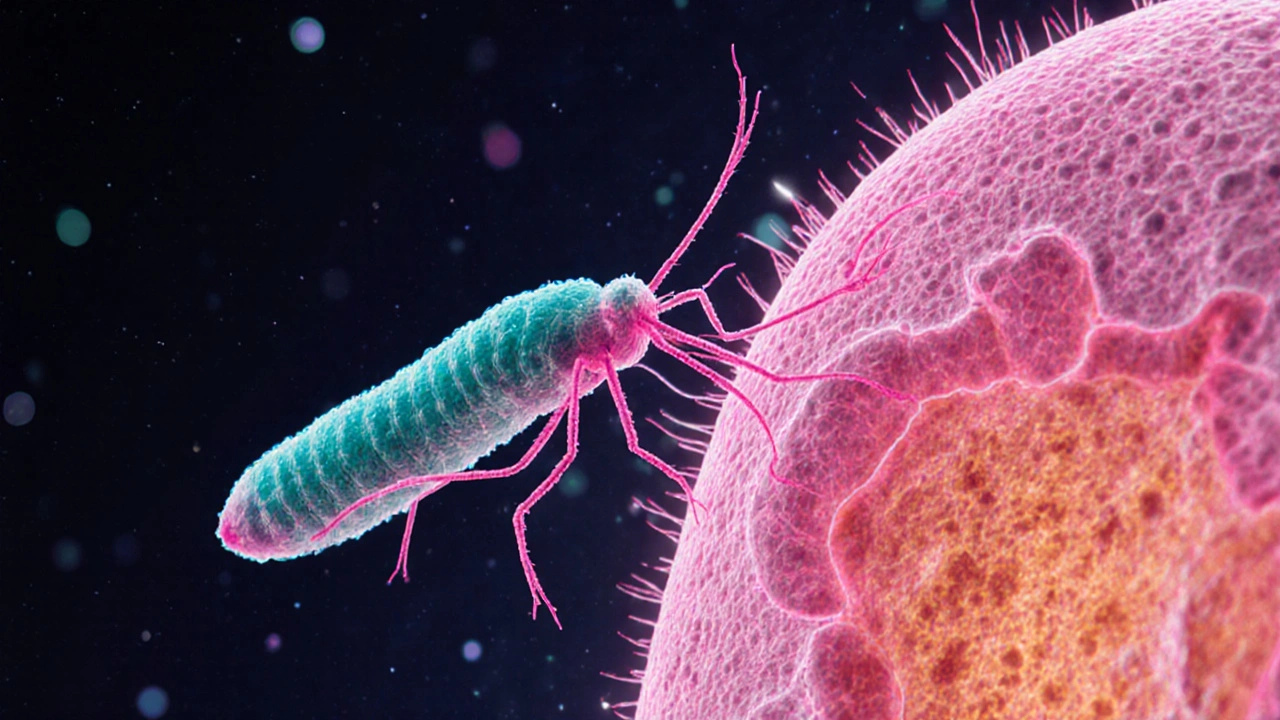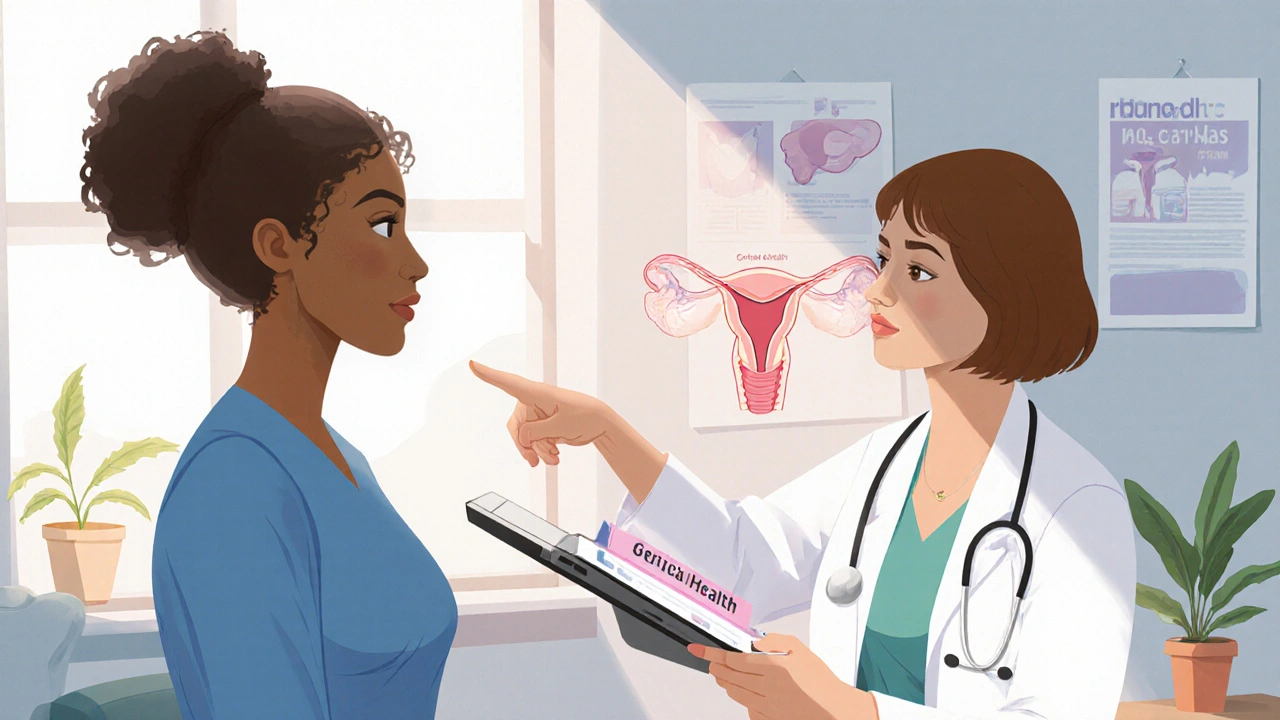When a common STI shows up in the headlines alongside a deadly cancer, it’s easy to wonder if the two are really linked or just a coincidence. The answer isn’t just “yes” or “no”-there’s solid science, real‑world data, and practical steps you can take right now. Below we break down what Trichomoniasis and cervical cancer have in common, why the connection matters, and how you can protect yourself.
What Is Trichomoniasis?
Trichomoniasis is a sexually transmitted infection caused by the protozoan Trichomonas vaginalis. It spreads through vaginal, oral, or anal sex and affects an estimated 13 million people in the United States each year, according to the CDC. Most cases are mild: itching, burning, and a frothy discharge. Yet up to 70% of infected women report no symptoms at all, which makes routine screening essential.
The parasite thrives in an environment where the natural balance of the vaginal microbiome is disrupted. Its presence triggers inflammation, alters pH, and can weaken the protective lining of the cervix.
Understanding Cervical Cancer
Cervical cancer is a malignant growth that starts in the cells of the cervix, the lower part of the uterus that opens into the vagina. In the U.S., about 14,000 new cases are diagnosed annually, and roughly 4,000 women die from the disease each year. The main driver is persistent infection with high‑risk types of Human Papillomavirus (HPV), especially types 16 and 18. However, other factors-smoking, immune suppression, and co‑existing STIs-can amplify risk.
The Science Linking Trichomoniasis and Cervical Cancer
Researchers have been studying the link for over a decade. Several large cohort studies (e.g., a 2022 analysis of 1.2 million women in the Nordic registries) found that women with a documented Trichomoniasis infection had a 1.6‑fold higher odds of developing cervical cancer compared to those without the infection.
Why does this happen? Three main mechanisms are recognized:
- Inflammation: The parasite provokes chronic inflammation, releasing cytokines like IL‑6 and TNF‑α. These molecules can damage DNA and promote the survival of cells already infected with HPV.
- Microbiome Disruption: A healthy vaginal microbiome-dominated by Lactobacillus species-helps keep HPV in check. Trichomoniasis tilts the balance toward anaerobic bacteria, creating an environment where HPV persists and integrates into host DNA.
- Immune Modulation: The infection can suppress local immune responses, reducing the ability of the cervix to clear HPV‑infected cells.
In short, Trichomoniasis doesn’t cause cancer on its own, but it throws off the defenses that normally keep HPV from turning malignant.
Who’s at Higher Risk?
Understanding who is most vulnerable helps you decide whether extra screening is worth it. Look for these red flags:
- Women under 30 who report multiple recent partners.
- Those with a history of other STIs (chlamydia, gonorrhea, HSV).
- Individuals who smoke or use tobacco products.
- People with weakened immune systems, such as those on long‑term steroids or living with HIV.
If you fit any of these categories, discuss a combined STI and cervical cancer screening plan with your provider.

Screening & Early Detection
Early detection saves lives, and the good news is that both conditions have established screening tools.
- Pap test (Pap smear): Recommended every three years for women aged 21‑65. It looks for abnormal cervical cells that could become cancerous.
- HPV DNA test: Often done alongside a Pap test (co‑testing) after age 30. Detects high‑risk HPV strains.
- Trichomoniasis testing: A simple vaginal swab or urine test can detect the parasite. Many clinics offer it as part of routine STI panels.
When a Pap test shows atypical cells, the doctor may perform a colposcopy to examine the cervix more closely. If Trichomoniasis is present, treating it promptly reduces inflammation and gives the immune system a better chance to fight HPV.
Prevention & Treatment
Preventing one infection helps guard against the other.
- Vaccinate: The HPV vaccine (Gardasil9) shields against the seven high‑risk HPV types that cause about 90% of cervical cancers. It’s approved for ages 9‑45 and is most effective when given before sexual activity begins.
- Safe sex practices: Consistent condom use lowers the risk of Trichomoniasis by about 50% and also reduces HPV transmission.
- Regular STI screening: Detecting and treating Trichomoniasis early (usually with a single dose of Metronidazole) cuts inflammation and restores the microbiome faster.
- Maintain a healthy microbiome: Probiotic‑rich foods (yogurt, kefir) and, when appropriate, vaginal probiotic supplements can help keep Lactobacillus dominant.
- Quit smoking: Smoking compounds the DNA‑damage caused by inflammation, so quitting reduces overall cancer risk.
Practical Checklist: What to Do Right Now
| Action | Why It Helps | How to Implement |
|---|---|---|
| Get HPV vaccinated | Prevents the primary cause of cervical cancer | Schedule the three‑dose series with your doctor or pharmacy |
| Ask for a Trichomoniasis screen | Detects hidden infection that fuels inflammation | Include it in your next STI panel or annual check‑up |
| Have a Pap/HPV co‑test every 3‑5 years | Catches abnormal cells before they turn cancerous | Follow your provider’s schedule after age 21 |
| Use condoms consistently | Reduces transmission of both Trichomoniasis and HPV | Keep a supply on hand and use from start to finish |
| Quit smoking | Lowers DNA‑damage and improves immune response | Seek counseling, nicotine patches, or apps for support |
| Support your vaginal microbiome | Helps clear HPV and reduces infection recurrence | Eat probiotic foods, consider a clinician‑recommended probiotic |
Frequently Asked Questions
Can Trichomoniasis cause cervical cancer on its own?
No. The parasite alone isn’t carcinogenic. It creates inflammation and microbiome changes that can help high‑risk HPV persist, which is the real driver of cervical cancer.
If I’ve been treated for Trichomoniasis, does my cervical cancer risk go back to normal?
Treating the infection reduces inflammation quickly, but the risk depends on whether HPV is still present. Continuing regular Pap/HPV testing is the safest approach.
Is there a vaccine for Trichomoniasis?
Not yet. Researchers are exploring vaccine candidates, but for now prevention relies on safe‑sex practices and early testing.
How often should I get screened for Trichomoniasis?
If you have risk factors (multiple partners, previous STIs), annual screening is wise. Otherwise, testing during a routine pelvic exam or if symptoms appear is sufficient.
Can men be carriers of Trichomoniasis even without symptoms?
Yes. Men often have no symptoms but can still spread the parasite. Testing men who have sex with women is an important part of breaking the cycle.

 Sep, 28 2025
Sep, 28 2025

Matt Laferty
September 28, 2025 AT 22:23When you read about the link between Trichomoniasis and cervical cancer, the first thing that strikes you is the sheer complexity of the underlying biology. The parasite itself is a sneaky protozoan that thrives in an altered vaginal environment, and that alone sets the stage for trouble. Chronic inflammation caused by the infection releases a cascade of cytokines, including IL‑6 and TNF‑α, which are notorious for damaging DNA. Those damaged cells become fertile ground for high‑risk HPV to embed its oncogenic DNA. At the same time, the microbiome shifts away from Lactobacillus dominance toward a more anaerobic community that further weakens the cervix’s natural defenses. Imagine the cervix as a fortress; Trichomoniasis is like a subtle, persistent siege that erodes the walls while HPV plants its flag. Studies from the Nordic registries encompassing over a million women have quantified this risk, showing a 1.6‑fold increase in cervical cancer odds for those with documented infections. This isn’t a casual association; it’s a statistically robust finding that has survived multiple adjustments for confounding variables. The mechanisms are interwoven: inflammation, microbiome disruption, and immune modulation all act in concert. Each pathway alone might not be sufficient, but together they create a perfect storm. Moreover, the risk isn’t limited to a single episode; recurrent or untreated infections can sustain the inflammatory milieu for years. This underscores the importance of regular screening for both STI and cervical abnormalities. The good news is that both Pap smears and Trichomoniasis tests are widely available and relatively inexpensive. Early detection allows for timely treatment with Metronidazole, which can quell inflammation and restore microbial balance. Concurrently, prophylactic HPV vaccination shields against the primary oncogenic driver. Lifestyle interventions like quitting smoking and incorporating probiotic‑rich foods further bolster the cervix’s resilience. In sum, while Trichomoniasis is not a direct cause of cancer, it is a potent accelerator that tips the scales in favor of malignancy when HPV is present. The take‑away message is clear: don’t ignore the silent infection, and stay on top of your screening schedule.
Genie Herron
September 28, 2025 AT 23:13It feels heartbreaking seeing how many women suffer in silence
Danielle Spence
September 29, 2025 AT 00:20We must hold ourselves accountable for the spread of STIs; ignoring them is morally reprehensible and puts countless lives at risk, especially when the downstream effects can be as severe as cancer. The data is clear, and we have the tools to prevent this cascade of harm, so complacency is simply unacceptable.
Dhanu Sharma
September 29, 2025 AT 01:26yeah the info is solid but most folks just think it’s another thing you can ignore until it hits you like a surprise
Edward Webb
September 29, 2025 AT 02:33Matt makes a compelling case for integrating STI testing with routine cervical screening, noting that the inflammatory cascade triggered by Trichomoniasis can synergize with HPV to promote oncogenesis. This perspective aligns with the current consensus that a multidisciplinary preventive approach yields the best outcomes for women’s health.
Snehal Suhane
September 29, 2025 AT 03:40Oh great another "expert" trying to sound smart while dropping typos like it’s a hobby; maybe if you actually read the studies you’d realize the risk isn’t some mythic danger but a modest statistical uptick.
Ernie Rogers
September 29, 2025 AT 04:46We should focus on American health standards first before getting lost in overseas data that doesn’t reflect our reality
Eunice Suess
September 29, 2025 AT 05:53While the article is thorough, it’s riddled with grammatical inconsistencies that could confuse readers; precision matters when discussing medical information, not just dramatic flair
Anoop Choradia
September 29, 2025 AT 07:00One must consider the broader context of pharmaceutical interests that subtly influence research outcomes; the alleged link may serve as a conduit for profit‑driven vaccination campaigns, a notion worthy of deeper scrutiny.
bhavani pitta
September 29, 2025 AT 08:06Contrary to popular belief, the correlation does not imply causation, and raising alarm may detract from more pressing public health priorities that deserve our attention.
Brenda Taylor
September 29, 2025 AT 09:13Wow that’s a lot to take in 😅
virginia sancho
September 29, 2025 AT 10:20Honestly, the best takeaway is to schedule that pap and HPV test if you haven’t already – it’s a simple step that can catch issues early and give you peace of mind.
Namit Kumar
September 29, 2025 AT 11:26👍🏼 Good point, let’s get those checks done!
Sam Rail
September 29, 2025 AT 12:33Seems like another health scare that we’ll forget about soon enough.
Pathan Jahidkhan
September 29, 2025 AT 13:40Think of the cervix as a philosophical arena where the forces of inflammation and viral mutability wrestle for dominance, each movement echoing the ancient dialectic of chaos versus order. When the parasite tips the balance, it is not mere coincidence but a manifestation of deeper biological narratives.
Dustin Hardage
September 29, 2025 AT 14:46Pathan’s metaphor captures the essence of the interplay, but empirical evidence remains the cornerstone; clinicians must prioritize evidence‑based screening protocols above poetic interpretations.
Dawson Turcott
September 29, 2025 AT 15:53Oh sure, because we all have time to read philosophy when we’re trying to get a pap done.
Alex Jhonson
September 29, 2025 AT 17:00Let’s remember that health education is a community effort, and sharing clear, colorful information helps everyone stay informed and empowered.
Katheryn Cochrane
September 29, 2025 AT 18:06This post downplays the real danger by overcomplicating the issue; the takeaway is simple – get screened or risk becoming another statistic.